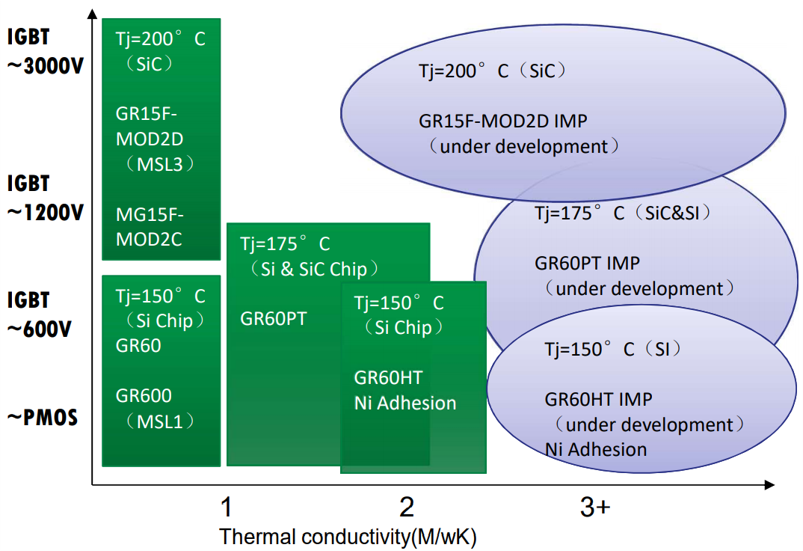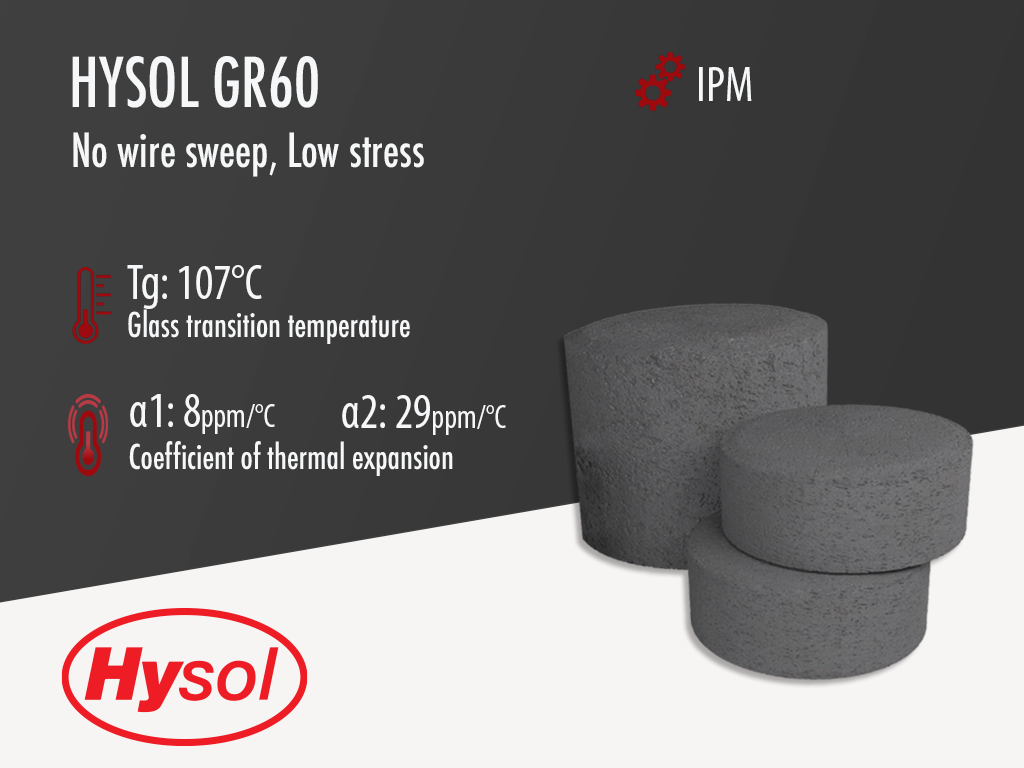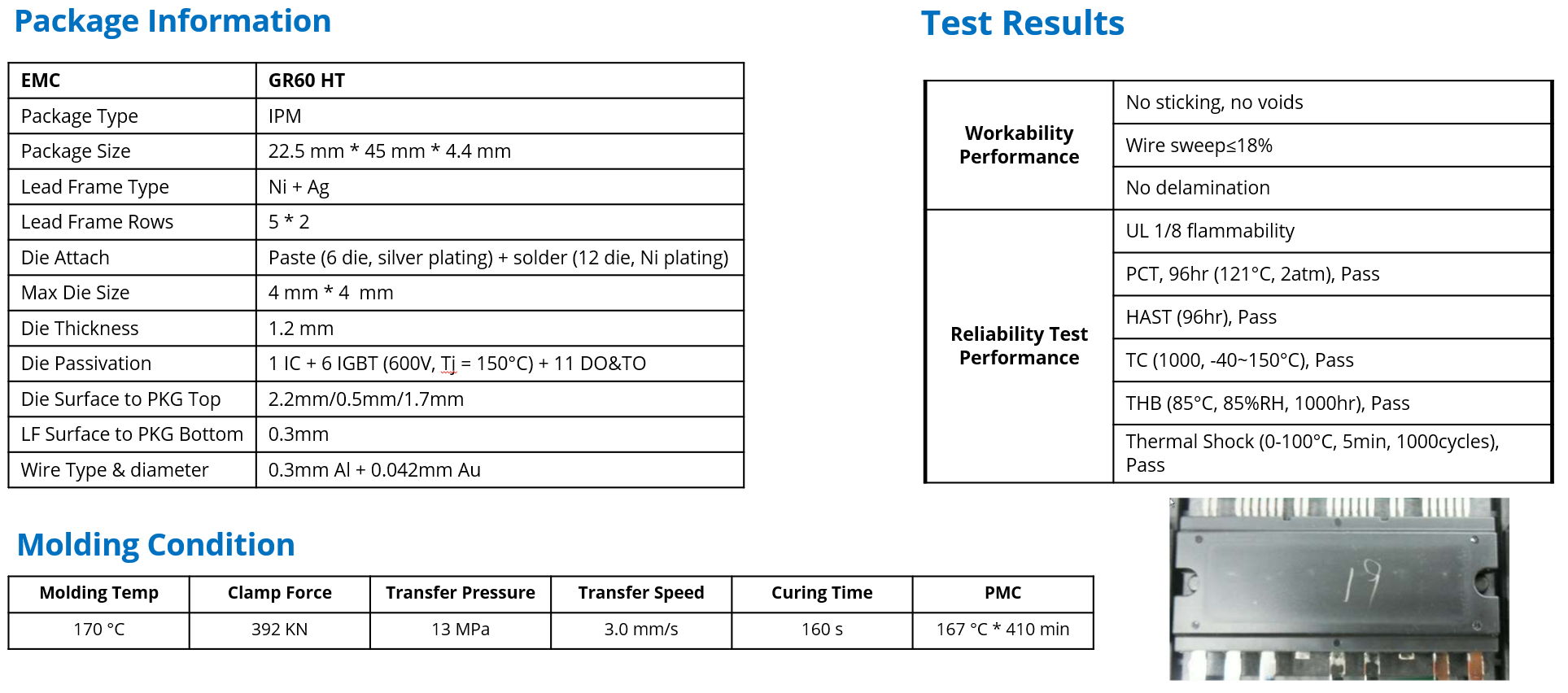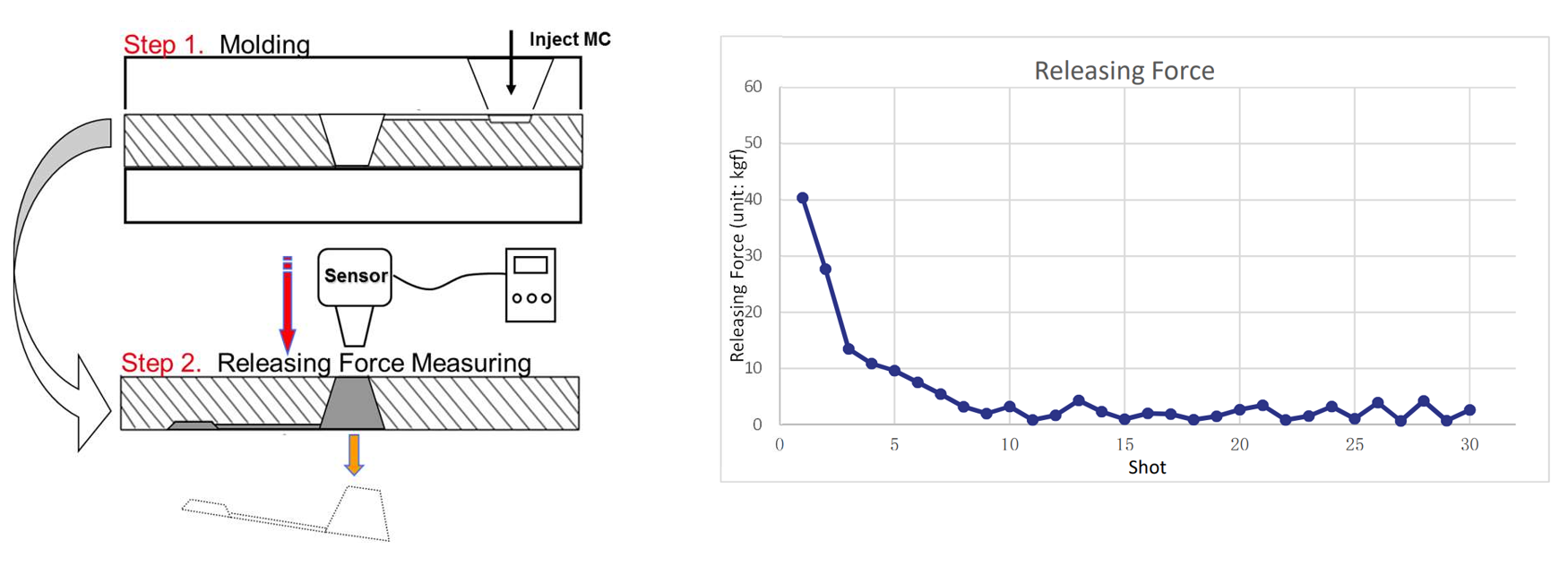Hysol GR60 | Black Epoxy Mold Compound
- Designed for IPM application
- Good moisture resistance
- High thermal conductivity
Product Description
Hysol GR60 Series is a black semiconductor-grade epoxy molding compound designed for the encapsulation and protection of intelligent powder module (IPM) applications. With excellent workability and reliability, GR60 series is suitable for long wire or large body devices. With high thermal conductivity (1.7 ~ 2.2 W/mk), GR60 could be applied in SiC IGBT module with Tj 175°C and 1200V. More thermal conductive versions are also under development. Hysol GR60 is an environmentally "green" product, meaning that it doesn't contain any halogens including bromine, antimony or phosphorus flame retardants. Hysol GR60 meets UL 94 V-0 Flammability at 1/8 inch thickness. Key features are summarized as:
Reliability (check GR60 HT beta-site tests)
- High adhesion to Cu/Ag/Ni
- Low stress and low water absorption
- High thermal conductivity
- Excellent performance in HAST, HTRB, TC, PCT, HTS, etc.
Moldability
- Excellent workability with wide process window
- No wire sweep
- Good warpage control
Available versions: GR60 HT, GR60 PT (check the GR60 comparison)
Suitable Package: Full pack type IPM, substrate type IPM
Technical Specifications
| General Properties | |
| Color Color The color | black |
| Filler Content | 87 % |
| Thermal Properties | |
| Glass Transition Temperature (Tg) Glass Transition Temperature (Tg) The glass transition temperature for organic adhesives is a temperature region where the polymers change from glassy and brittle to soft and rubbery. Increasing the temperature further continues the softening process as the viscosity drops too. Temperatures between the glass transition temperature and below the decomposition point of the adhesive are the best region for bonding. The glass-transition temperature Tg of a material characterizes the range of temperatures over which this glass transition occurs. | 107 °C |
| Thermal Conductivity Thermal Conductivity Thermal conductivity describes the ability of a material to conduct heat. It is required by power packages in order to dissipate heat and maintain stable electrical performance. Thermal conductivity units are [W/(m K)] in the SI system and [Btu/(hr ft °F)] in the Imperial system. | 0.9 W/m.K |
| UL 94 Rating UL 94 Rating Flammability rating classification. It determines how fast a material burns or extinguishes once it is ignited. HB: slow burning on a horizontal specimen; burning rate less than 76 mm/min for thickness less than 3 mm or burning stops before 100 mm V-2: burning stops within 30 seconds on a vertical specimen; drips of flaming particles are allowed. V-1: burning stops within 30 seconds on a vertical specimen; drips of particles allowed as long as they are not inflamed. V-0: burning stops within 10 seconds on a vertical specimen; drips of particles allowed as long as they are not inflamed. 5VB: burning stops within 60 seconds on a vertical specimen; no drips allowed; plaque specimens may develop a hole. 5VA: burning stops within 60 seconds on a vertical specimen; no drips allowed; plaque specimens may not develop a hole | V-0 @ 1/8 inch |
| Electrical Properties | |
| Volume Resistivity Volume Resistivity Volume resistivity, also called volume resistance, bulk resistance or bulk resistivity is a thickness dependent measurement of the resistivity of a material perpendicular to the plane of the surface. | 8.3x1015 Ohms⋅cm |
| Chemical Properties | |
| Moisture absorption | 0.34 % |
| Physical Properties | |
| Spiral Flow @ 175°C | 152.4 cm |
| Viscosity Viscosity Viscosity is a measurement of a fluid’s resistance to flow. Viscosity is commonly measured in centiPoise (cP). One cP is defined as the viscosity of water and all other viscosities are derived from this base. MPa is another common unit with a 1:1 conversion to cP. A product like honey would have a much higher viscosity -around 10,000 cPs- compared to water. As a result, honey would flow much slower out of a tipped glass than water would. The viscosity of a material can be decreased with an increase in temperature in order to better suit an application | 13 mPa.s |
Additional Information
| Property | GR60PT(98D69B) | GR60PT(102A11) | GR60HT | GR60 (M1) |
| Filler content | 83 | 86 | 86 | 87 |
| Epoxy | EOCN+LWA1 | EOCN+LSR | EOCN/LWA2 | MAR+LWA2 |
| Gel Time (sec) | 32 | 30 | 40 | 30 |
| Spiral Flow (inch) | 40 | 29 | 24 | 60 |
| Tg (°C) | 172 | 117 | 119 | 107 |
| CTE 1 | 20 | 15 | 19 | 8 |
| CTE 2 | 61 | 49 | 44 | 29 |
| Flexural Strength/Modulus, Mpa | 116/ 17925 | 110/ 21112 | 137/ 19625 | 145/ 22580 |
| DMA-Flexural Modulus (RT) | 21141 | 25377 | - | 26971 |
| DMA-Flexural Modulus (175/260°C) | 2377/795 | 613/453 | - | 888/ 647 |
| PCT 24hrs wt% | 0.45 | 0.22 | 0.20 | 0.34 |
| CI-, ppm | 34 | 18 | 9 | 9 |
| Na+, ppm | 5 | 3 | 8 | 4 |
| pH, ppm | 7 | 7 | 6 | 5 |
| Volume Resistivity, 10E15 Q | 2 | 7 | 4.09 | 83 |
| Thermal Conductivity, W/m.K | 1.9 | 1.8 | 2.2 | 0.9 |
Epoxy Molding Compound For IPM Application
Hysol has developed different series (GR60 series, GR600 series, GR750 series, etc.) for IPM application. Highly conductive versions are also in development.
Beside the common features, the two version GR60 PT and GR60 HT have their own unique features to meet niche requirements for your module. The differences between GR60 PT and GR60 HT:
- Thermal conductivity: 1.7 W/mK (GR60 PT) v.s. 2.2 W/mK (GR60 HT)
- Good adhesion to: Cu & Au surface (GR60 PT) v.s. Cu & Au & Ni surface (GR60 HT)
- Others: high cost-efficient (GR60 PT) and good moisture resistance (GR60 HT)
Hysol GR60 series products are highly thermal conductive molding compounds designed for IPM applications. Both GR60 HT and GR60 PT are dedicated to module package with excellent workability and reliability, suitable for long wire or large body device. The key common features of GR60HT and GR60PT are:
Workability
- No wire sweep
- Warpage control
- Wide molding window
Great peformance
- Good electrical stability during tests
- High thermal conductivity
- Flammability rating UL94 V-0 @1/8 inch






